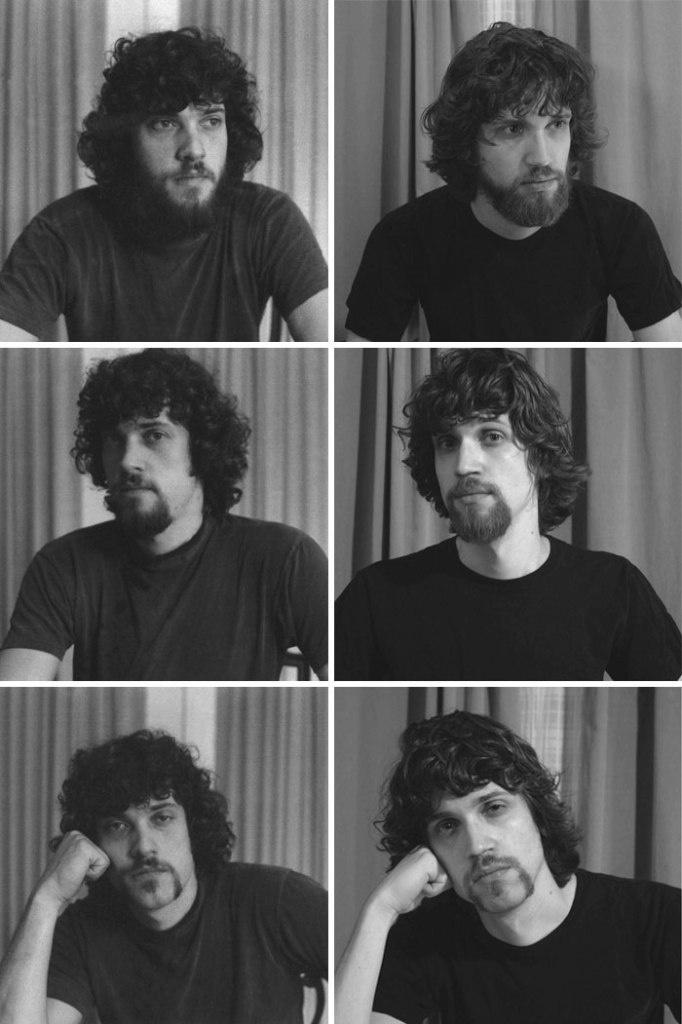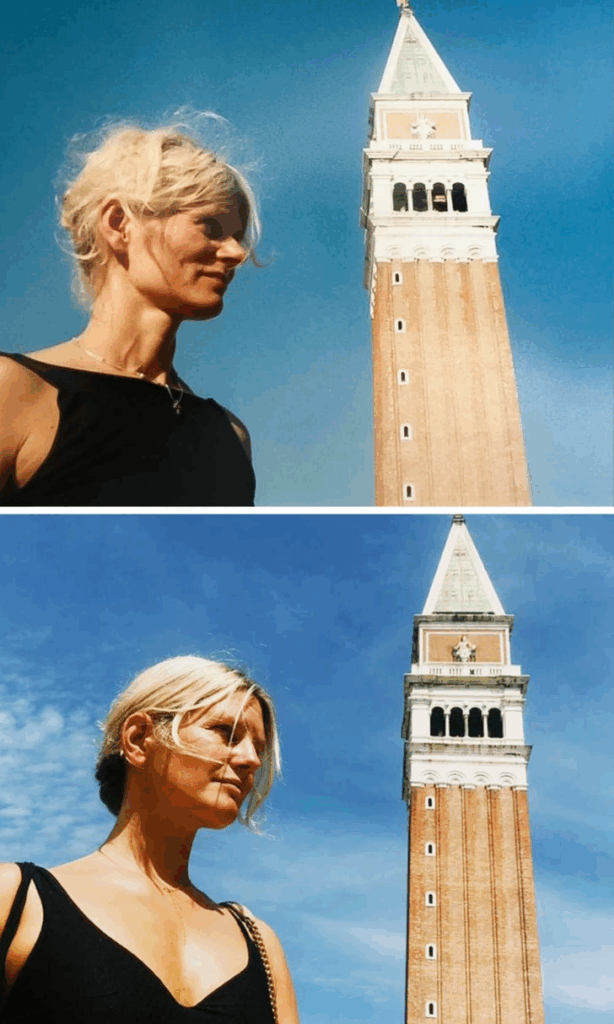Family resemblance is one of the most visible results of genetics at work. Children receive half of their DNA from their mother and half from their father, which means a precise genetic mix shapes their appearance. Sometimes this balance leads to unique combinations, but in many cases, the result is a child who looks almost identical to one parent. The similarities can be so strong that side-by-side photos of parents and children at the same age look nearly interchangeable. This effect is seen across everyday families, celebrities, and even historical records, showing how predictable yet surprising inheritance can be.
Hair and Eye Color Passed Down

Hair and eye color are some of the most obvious traits that create strong parent-child resemblance. These features are influenced by multiple genes, but dominant ones often decide the outcome. For example, darker hair and eye colors are more likely to appear in children, even if one parent has lighter features. Families often notice these repeating patterns when comparing photos across generations. While there can still be surprises due to recessive genes, these traits remain some of the clearest examples of visible inheritance.
Expressions That Look the Same

Beyond physical features, children often share the same expressions as their parents. A smirk, the way someone raises their eyebrows, or even how they laugh, can look identical across generations. These similarities come from a mix of inherited muscle structure and learned behavior. Family photos often capture these expressions, making parent and child appear even more alike than they already do.
The Power of Genes at Work

DNA acts as a set of biological instructions that determines visible traits like eye shape, hair color, and bone structure. When certain dominant traits align, they can produce extremely strong resemblances between parent and child. Even details such as freckles, the angle of a smile, or the curve of an eyebrow can be passed down precisely. This is often described as phenotypic expression, meaning how genetic codes appear in physical traits. The more dominant features a child inherits from one parent, the greater the likelihood they look almost identical to that parent in photos and daily life.
Fathers and Sons with Matching Features

Many fathers are surprised when they see their younger selves reflected in their sons. Jawlines, noses, and eye spacing are commonly inherited features that create this strong resemblance. Some research suggests that visible similarity between father and child helped establish kinship in human history. Family photographs often highlight the resemblance, where side-by-side comparisons can look nearly like copies. These similarities remain clear into adulthood, sometimes making fathers and sons appear closely related, even to people meeting them for the first time.
Mothers and Daughters Who Could Be Sisters

Mother-daughter resemblance often shows up in facial structures and hair. Cheekbones, lip shape, and skin tone frequently match in ways that make people remark how similar the two look. Studies show that daughters often strongly carry maternal traits, as specific facial proportions are passed through the female line. When compared at the same age, mothers and daughters can appear closer than they are. These comparisons are particularly noticeable during teenage and young adulthood, when growth emphasizes shared characteristics.
Celebrity Families with Striking Likeness

Well-known families in entertainment provide clear illustrations of inherited traits. Reese Witherspoon and her daughter Ava often draw attention because of their nearly identical looks. Similarly, Jaden Smith mirrors many of Will Smith’s features, from bone structure to expressions. These examples are regularly discussed in media coverage because the resemblance is so easy to see. In such cases, likeness becomes part of the celebrity story and adds to public interest in family ties.
Traits That Skip a Generation

Not every child looks like their parents, as genetic inheritance can cause traits to appear after skipping one or more generations. For example, a child might inherit a grandparent’s curly hair, eye shape, or dimples rather than either parent’s. This happens because recessive genes can remain hidden until the right combination activates them again. Families often notice this when comparing old childhood photos across multiple generations.
Genetic Science Behind Resemblance

The science of resemblance lies in the way genes interact. Traits such as facial symmetry, height, or skin tone are influenced by multiple genes working together, not just one. Dominant traits increase the chances of a child looking like a particular parent, but recessive ones also shape the outcome. This mix explains why some children appear almost identical to one parent while others look very different.
Children Taking After Just One Parent

In many families, children inherit the majority of their visible traits from a single parent. This can make the resemblance so strong that people often comment on how much the child looks like either the mother or the father. Features such as eye shape, jawline, or smile sometimes pass down almost unchanged. In these cases, the influence of one parent’s genetics can appear to overshadow the other’s contribution.
Psychological Perception of Similarity

Humans are quick to recognize resemblance among family members. Research suggests that parents often feel a closer bond when they notice similarities in appearance. From an evolutionary perspective, resemblance may have acted as a cue of relatedness and trust. Even outside the family, observers can often spot who is related based on facial features alone. The ability to notice likeness is part of how people process and identify familiar faces.
Everyday Examples Outside of Fame

Celebrity examples are well known, but the exact resemblances occur in families everywhere. Old albums and yearbooks frequently reveal children who look almost identical to their parents at the same age. Comparing photos often highlights matching features such as smiles, jawlines, or hairlines. Similar clothing styles and haircuts from different decades can make the resemblance stand out even more.
Why Some Children Look Different

Not all children inherit their parents’ most visible features. Genes interact in complex ways that can emphasize hidden traits instead. This sometimes results in children who resemble extended family members or appear unique within the household. Siblings can also look very different from one another because of the random assortment of inherited genes.
Inherited Mannerisms and Gestures

Resemblance is not limited to physical traits. Children often pick up expressions, posture, or other habits that make them look more like their parents. Some of these are learned behaviors, while genetics may influence others. How a person smiles or tilts their head can create similarities beyond bone structure alone. These combined traits often make parent-child resemblances appear stronger than they would be based on DNA alone.
Generational Comparisons Through Photos

Family photos often provide clear evidence of resemblance across time. A child’s school picture may look nearly identical to one of their parent or even a grandparent at the same age. Similar features stand out even when hairstyles or clothing trends differ. Families often use these photos to trace physical traits across multiple generations.
Daughters Resembling Fathers

In many cases, daughters inherit apparent physical similarities from their fathers. Features such as brow shape, chin structure, and facial proportions often match closely. These traits remain visible even as daughters grow older and develop their own styles. The resemblance demonstrates how paternal genetics strongly shape daughters as well as sons. It also shows that appearance is not tied strictly to gender lines in inheritance.
Sons Resembling Mothers

Sons often show an unmistakable resemblance to their mothers. Features like eyes, cheekbones, and skin tone are frequently inherited on the maternal side. These traits can stand out more strongly when compared with siblings who resemble the father. Each child may express a different balance of parental genetics, but maternal influence is often apparent.
Social Media Comparisons

Side-by-side photos of parents and children at the same age are common online. These images often gain attention because of how identical they appear. Viewers are quick to comment on the precision of the resemblance, sometimes suggesting the photos look like duplicates. The rise of social media has turned these comparisons into viral content.
Read More: 10 Smart Safety Habits Practiced by Danger-Savvy Kids
Lifestyle Factors That Strengthen Resemblance

Environmental factors also shape how strongly children resemble their parents. Shared diets, exercise routines, and skincare practices can make features appear more alike. Living in the same environment often creates similar skin tone changes due to sun exposure. Daily habits, including expressions and posture, add to the impression of resemblance.
Everyday Families That Show Clear Likeness

Resemblance between parents and children is not limited to celebrities or well-known figures. In everyday families, children often grow up looking like direct copies of their mother or father. Old school portraits, casual snapshots, and family albums highlight just how striking these similarities can be. Many parents notice the connection when they compare childhood photos of themselves with their children at the same age.
Why People Notice Look-Alikes So Quickly

The human brain is specialized for recognizing faces and detecting similarities. Dedicated areas in the brain process facial features and identify familiar patterns. This ability allows people to spot family resemblances almost instantly. It also explains why relatives are often identified correctly even by strangers. Recognizing likeness is an automatic part of how humans interpret social connections.
Resemblances That Are Undeniable

Strong resemblances between parents and children are clear examples of inheritance in action. Visible traits such as eye color, bone structure, and expressions pass from generation to generation. Some traits come directly from parents, while others skip a generation before resurfacing. Families often observe and compare these similarities across decades.
Children who closely resemble their parents provide direct evidence of how genetics shapes appearance. Traits such as smiles, jawlines, and skin tone often pass down with remarkable accuracy. Some children look like near duplicates of their parents, while others show more variation due to recessive traits. Family resemblances will continue to appear as clear markers of how DNA influences each new generation.
Disclaimer: This article was created with AI assistance and edited by a human for accuracy and clarity.
Read More: Ohio Couple and Their Newborn Twins All Share the Same Birthday in Rare Family Moment

